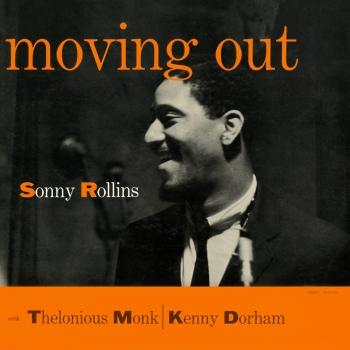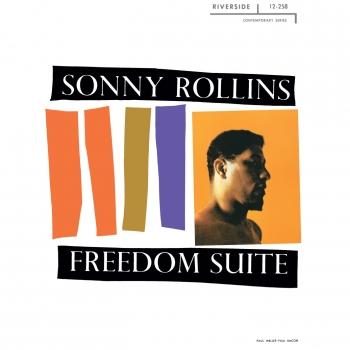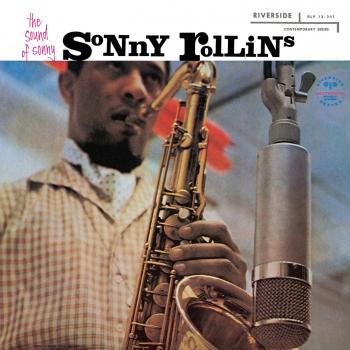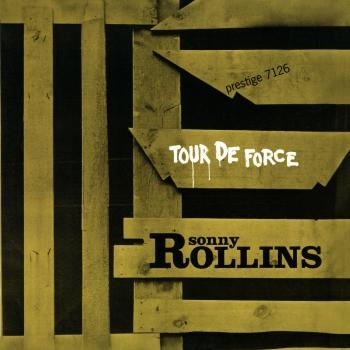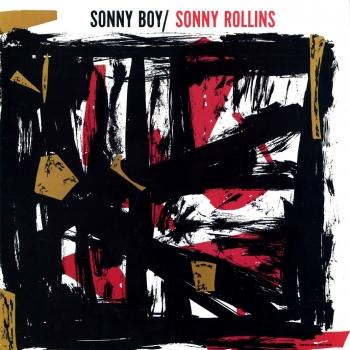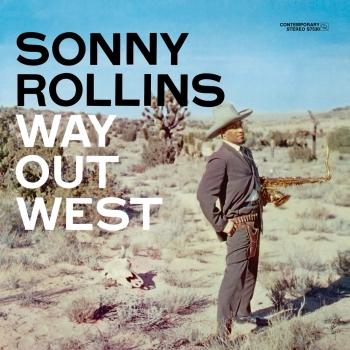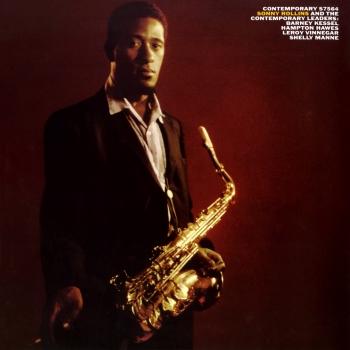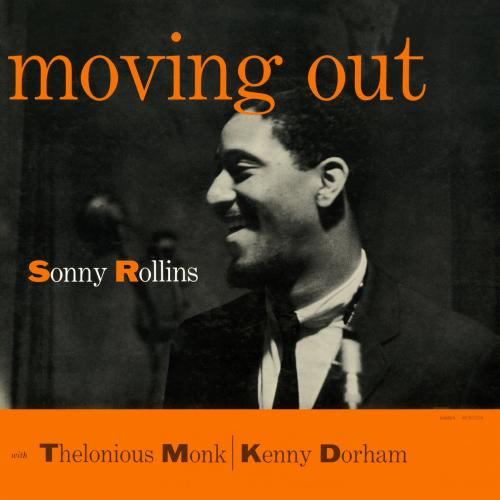
Moving Out (Remastered) Sonny Rollins
Album Info
Album Veröffentlichung:
1956
HRA-Veröffentlichung:
20.01.2017
Das Album enthält Albumcover Booklet (PDF)
Entschuldigen Sie bitte!
Sehr geehrter HIGHRESAUDIO Besucher,
leider kann das Album zurzeit aufgrund von Länder- und Lizenzbeschränkungen nicht gekauft werden oder uns liegt der offizielle Veröffentlichungstermin für Ihr Land noch nicht vor. Wir aktualisieren unsere Veröffentlichungstermine ein- bis zweimal die Woche. Bitte schauen Sie ab und zu mal wieder rein.
Wir empfehlen Ihnen das Album auf Ihre Merkliste zu setzen.
Wir bedanken uns für Ihr Verständnis und Ihre Geduld.
Ihr, HIGHRESAUDIO
- 1 Moving Out 04:31
- 2 Swingin' For Bumsy 05:49
- 3 Silk 'N' Satin 04:03
- 4 Solid 06:27
- 5 More Than You Know 10:49
Info zu Moving Out (Remastered)
Following on the heels of his magisterial work with Miles Davis on Bags’s Groove, Sonny Rollins entered Van Gelder Studios with a fire-breathing quintet on August 18, 1954, resulting in four of the five selections which make up „Moving Out“. This session might just as well have been titled "Busting Out," because „Moving Out“ represents a breakthrough for Rollins as a bandleader and an improviser.
Rollins really stretches out on the title tune and "Swingin' For Bumsy," playing with a new-found rhythmic command and melodic authority--spreading his wings and flying with Bird-like harmonic declamations, and a dramatic flair all his own. The oft-neglected Kenny Dorham proves a brash soaring foil, but it is the legendary pianist Elmo Hope who really arouses the Heath Blakey axis. Hope's dense, dancing accompaniements prod the soloists into uncharted waters, while his limber, sprawling improvisations represent a singular school of modern piano, occupying a space somewhere between Bud Powell and Thelonious Monk. On the ballad "Silk N' Satin," Hope's brief interlude provides a dark spiritual contrast to Rollins' romantic yearning, while his blues shouts and broad harmonic brushstrokes on "Solid" inspire Rollins to really dig in and shout.
"More Than You Know" is an extra track from one of the sessions which produced Thelonious Monk and Sonny Rollins, and it is a ballad performance of enormous gravity. Under Monk's watchful eye--and thanks in part to the pianist's orchestral manner of feeding the soloist chords--you can hear the saxophonist beginning to move beyond the ballad stylings of Coleman Hawkins and Lester Young, and into a new, more personal realm of rhythmic and harmonic complexity. Meanwhile, Monk's extended solo is a remarkable roadmap of the master's harmonic devices, all in the service of the mood and the melody.
„The collaborations between Sonny Rollins and any given trumpet player were few and far between, but they did include such notables as Miles Davis, Don Cherry, Clifford Brown, and in this case, his first tandem partnership with Kenny Dorham. At the time, both of them were also members of the Max Roach Quintet, and thus quite familiar with each other's strengths. Add to the mix drummer Art Blakey, bassist Percy Heath, and emerging modern jazz pianist Elmo Hope, and this shapes up to be one of the more potent combos of 1954. It's pretty straightforward music featuring Rollins, with little involvement from Dorham except solos. The fast title track, based on the changes of "Donna Lee" or "Indiana," has the briefest melody line before Rollins leaps into eighth-note madness, while the very fleet "Swingin' for Bumsy" does the same, repeating the slimmest phrase three times. An all-time classic, "Solid" does have the two horns together, playing an established, bluesy unison thought, a beauty in economy, while the obligatory ballad "Silk 'n' Satin" is all Rollins wrapped in a fabric of sheen and softness. There's one track that features an entirely different band for some reason, as "More Than You Know" encompasses a full 11 minutes of this program, which in total is just shy of 32 minutes. This unmistakable melody is enveloped by Rollins and Thelonious Monk, with bassist Tommy Potter and drummer Art Taylor in support for a tune that is unlike the others in style and texture. Moving Out contains some fine music, especially for the time period.“ (Michael G. Nastos, AMG)
Sonny Rollins, tenor saxophone
Kenny Dorham, trumpet
Elmo Hope, piano
Percy Heath, bass
Art Blakey, drums
Thelonious Monk, piano (on More Than You Know)
Tommy Potter, bass (on More Than You Know)
Art Taylor, drums (on More Than You Know)
Recorded August 18 and October 25, 1954 at Van Gelder Studio, Hackensack
Produced by Bob Weinstock
Digitally remastered
Sonny Rollins
will go down in history as not only the single most enduring tenor saxophonist of the bebop and hard bop era, but also the greatest contemporary jazz saxophonist of them all. His fluid and harmonically innovative ideas, effortless manner, and easily identifiable and accessible sound have influenced generations of performers, but have also fueled the notion that mainstream jazz music can be widely enjoyed, recognized, and proliferated. Born Theodore Walter Rollins in New York City on September 7, 1930, he had an older brother who played violin. At age nine he took up piano lessons but discontinued them, took up the alto saxophone in high school, and switched to tenor after high school, doing local engagements. In 1948 he recorded with vocalist Babs Gonzales, then Bud Powell and Fats Navarro, and his first composition, "Audubon," was recorded by J.J. Johnson. Soon thereafter, Rollins made the rounds quickly with groups led by Art Blakey, Tadd Dameron, Chicago drummer Ike Day, and Miles Davis in 1951, followed by his own recordings with Kenny Drew, Kenny Dorham, and Thelonious Monk.
In 1956 Rollins made his biggest move, joining the famous ensemble of Max Roach and Clifford Brown, then formed his own legendary pianoless trio with bassist Wilbur Ware or Donald Bailey and drummer Elvin Jones or Pete La Roca in 1957, doing recorded sessions at the Village Vanguard. Awards came from Down Beat and Playboy magazines, and recordings were done mainly for the Prestige and Riverside labels, but also for Verve, Blue Note, Columbia, and Contemporary Records, all coinciding with the steadily rising star of Rollins. Pivotal albums such as Tenor Madness (with John Coltrane), Saxophone Colossus (with longstanding partner Tommy Flanagan), and Way Out West (with Ray Brown and Shelly Manne), and collaborations with the Modern Jazz Quartet, Clark Terry, and Sonny Clark firmly established Rollins as a bona fide superstar. He also acquired the nickname "Newk" for his facial resemblance to Brooklyn/Los Angeles Dodgers pitcher Don Newcombe.
But between 1959 and 1961 he sought a less superficial, more spiritual path to the rat race society of the times, visiting Japan and India, studying yoga and Zen. He left the music business until 1962, when he returned with the groundbreaking and in many ways revolutionary recording The Bridge with guitarist Jim Hall for the RCA Victor/Bluebird label. Rollins struck up a working relationship with trumpeter Don Cherry; did a handful of innovative LPs for the RCA Victor, MGM/Metro Jazz, and Impulse! labels; did one record with his hero Coleman Hawkins; and left the scene again in 1968. By 1971 he came back with a renewed sense of vigor and pride, and put out a string of successful records for the Milestone label that bridged the gap between the contemporary and fusion jazz of the time, the most memorable being his live date from the 1974 Montreux Jazz Festival, The Cutting Edge. Merging jazz with calypso, light funk, and post-bop, the career of Rollins not only was revived, but thrived from then onward. He was a member of the touring Milestone Jazz Stars in 1978 with McCoy Tyner and Ron Carter, and gained momentum as a touring headliner and festival showstopper.
His finest Milestone recordings of the second half of his career include Easy Living, Don't Stop the Carnival, G-Man, Old Flames, Plus Three, Global Warming, This Is What I Do, and Without a Song: The 9/11 Concert. He has worked extensively with road and recording bands that have included such artists as electric bass guitarist Bob Cranshaw; trombonist Clifton Anderson; pianists Tommy Flanagan and Stephen Scott; keyboardist Mark Soskin; guitarists Bobby Broom and Jerome Harris; percussionist Kimati Dinizulu; and drummers Jack DeJohnette, Perry Wilson, Steve Jordan, and Al Foster. Rollins formed his own record label, Doxy, through which he issued the CD Sonny, Please in 2006. Well into his eighth decade of life, Rollins continued to perform worldwide. As a composer, he will always be known for three memorable melodies that have become standards and well-recognized tunes in the jazz canon -- "Oleo," "Airegin," and especially "St. Thomas." (Michael G. Nastos). Source: Blue Note Records.
Booklet für Moving Out (Remastered)


















